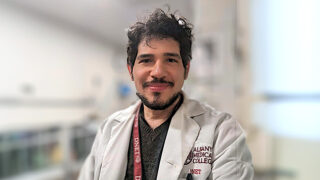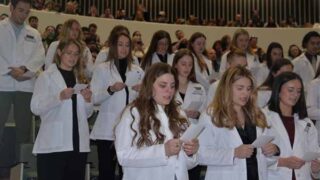Curriculum Overview
In their first year, residents focus on developing the skills needed to succeed in subsequent years while on core rotations, prior to taking call.
Call is an extremely important part of the resident’s learning and maturation process. First-year residents begin with a supervised call exposure during working hours in the Emergency Department, with both a senior resident and attending physician. In the latter half of the first year and throughout second year, residents gradually take on more responsibility in interpreting the studies during the evening hours, commensurate with their experience and knowledge. Senior residents on call are well prepared to efficiently protocol and interpret emergency and inpatient studies. They also perform and assist with pediatric on-call procedures.
Residents begin covering night float in their second year, during which they continue to develop more autonomy. A remote overnight attending radiologist is also available during this time to assist the resident, if needed.
Fourth year residents spend three months performing “mini-fellowships”, typically in the final three months before residents graduate and start their fellowships. Some choose to use this time as an opportunity for intensive study in a radiologic subspecialty field other than their chosen subspecialty, so that they have a second area of expertise when they enter the job market. Others use this time to begin early study in their subspecialty.
Conferences
Didactic conferences are held weekdays from noon to 1:30 p.m., during which subspecialty faculty present in both didactic and case presentation format. Additional morning lectures given by interventional radiology and musculoskeletal imaging providers are often scheduled between 7:15 and 8 a.m.
Each subspecialty follows a one- or two-year curriculum. Lectures are broadcast on WebEx to allow off-site residents to participate remotely, and are recorded and stored on our MediaSite for residents to access at their convenience.
First-year residents are given orientation lectures to learn the fundamentals in all subspecialties.
Residents participate in ongoing physics education throughout all four years, including weekly teleradiology physics lectures. We also provide a review course prior to the Core Examination, which our program includes for R3 (PGY-4) residents.
We regularly invite speakers from other institutions to present a Grand Rounds lecture, followed by an interactive case conference given by the guest lecturer. These lectures provide residents with an opportunity to network with respected faculty members from other institutions and to learn from them in an informal setting.
In addition, our Beyond Imaging lecture series covers additional topics of interest, including resident health and well-being, research, journal club, HIPAA, quality improvement, business of radiology, financial planning, and ethics.
Research
The Department of Radiology has a long history of biomedical and clinical research. Residents are strongly encouraged to participate as active members of investigative teams and financial support is provided for those who are selected to present their research at national conferences, including the Radiological Society of North America (RSNA), the Association of University Radiologists (AUR), the American Roentgen Ray Society (ARRS), the Society for Vascular and Interventional Radiology (SCVIR), and Society of Nuclear Medicine (SNM). Publications have been authored in most disciplines with a strong representation in body imaging, cardiothoracic imaging, musculoskeletal imaging, vascular and interventional radiology, and nuclear medicine.
Additional Opportunities
American Institute of Radiologic Pathology (AIRP) Course in Radiologic Pathology
The department provides tuition for all third-year residents to attend this four-week course in Silver Springs, Md., which presents residents with a comprehensive review of radiologic imaging with emphasis on the radiologic-pathology correlation.
Patient Safety and Clinical Competency Center (PSCCC)
Albany Medical College's PSCCC is an excellent resource for radiology residents. We utilize the PSCC for many teaching sessions including annual sessions on:
- Managing contrast reactions and codes targeted for the radiologist
- Ultrasound-guided core needle breast biopsy (utilizing breast gelatin models)
- Delivering bad news to simulated breast cancer patients
Ultrasound Scanning Boot Camp
We offer a week-long intensive ultrasound scanning boot camp in early September. Standardized patients from the PSCCC are available for residents to learn how to perform all the basic ultrasound exams, under the supervision of ultrasound technologists and body imaging attending radiologists.
Body Radiology
Our residents work with fellowship trained radiologists to interpret ultrasound, radiography, CT scans, and MRI examinations of the gastrointestinal and genitourinary systems, learning advanced imaging techniques for the liver and biliary tree, pancreas, spleen, adrenal glands, and kidneys. Working closely with our urologic colleagues, we offer additional specialization in imaging for female pelvic conditions, including MRI of pelvic floor disorders, and MRI of the prostate, including MR targeted biopsy. Our body radiologists interpret advanced imaging of the bowel with MR and CT enterorrhaphy, rectal MRI, and CT colonography, and use MRI to evaluate suspected fetal anomalies or placental abnormalities during pregnancy. We provide specialized imaging and interpretation of vascular abnormalities utilizing CT angiogram to evaluate the aorta and branch vessels arising from the aorta, suspected aortic dissection, aortic aneurysms, and evaluation of aortic endografts for complications. We also work closely with our plastic surgery colleagues to image abdominal wall vasculature for women undergoing breast reconstruction (DIEP or PAP flaps).
Breast Imaging
The Division of Breast Imaging offers patients the full complement of state-of-the-art, FDA-approved breast imaging, including screening and diagnostic mammography, ultrasound, MRI, tomosynthesis (3D mammography), and automated whole breast screening ultrasound. If an abnormality is detected on any imaging modality, we also offer our patients the full complement of image-guided biopsies, including ultrasound-guided aspiration and core biopsy, stereotactic/tomosynthesis biopsy, and MRI-guided biopsies.
Cardiothoracic Imaging
Utilizing x-ray, the latest-generation computed tomography (CT) imaging, and MRI, the Division of Cardiothoracic Imaging evaluates and diagnoses cardiac and pulmonary disorders. Our fellowship-trained cardiothoracic radiologists work in close collaboration pulmonologists, cardiothoracic surgeons, and cardiologists in the reading room and during multidisciplinary conferences to optimize patient imaging. During their first year, residents learn the basics of interpreting chest x-rays and chest CTs. In subsequent years, they participate in more advanced imaging, including cardiac MRI. We also offer a one year Cardiothoracic Fellowship for those looking for further specialization.
Emergency Radiology
As the regional Level 1 Trauma Center and a New York State Department of Health-designated Comprehensive Stroke Center, Albany Medical Center cares for a high volume of adult and pediatric patients from our region who may need emergency imaging. We also accept a large number of transfers of complex or critically ill patients from other hospitals around our region by ambulance or med flight. Our emergency radiologists work closely with our Emergency Department physicians, internists, pediatricians, surgeons, and subspecialists to care for our patients 24 hours a day, seven days a week, 365 days a year.
Fetal & Congenital Imaging
The fetal imaging radiologists specialize in MRI imaging of the fetus to evaluate fetal anatomy and growth. Our imagers are experts with years of experience in utilizing MRI to evaluate the in utero fetus and congenital anomalies identified on fetal ultrasound, including evaluation of fetal anomalies of the brain and spine, chest, cardiac, gastrointestinal, genitourinary, or musculoskeletal systems.
Musculoskeletal Imaging
Specializing in imaging studies of the bones, joints, and soft tissues, our fellowship-trained musculoskeletal radiologists evaluate bone and soft tissue tumors, musculoskeletal trauma, sports injuries, arthritis, metabolic bone disease, and rheumatologic disorders. Our radiologists perform joint injections and aspirations for diagnosis and therapeutic purposes and we also offer musculoskeletal ultrasound imaging of tendon and soft tissue pathology. Biopsies of bones and soft tissue lesions are performed by our interventional radiology colleagues. Our MSK imagers also participate in a biweekly multidisciplinary sarcoma conference with teams from orthopedic oncology and pathology to collaborate on patient treatment plans.
Neuroimaging
The Division of Neuroradiology provides high-level imaging of the central nervous system and head and neck for both adult and pediatric patients, including CT angiography/CT perfusion, MR angiograms, diffusion tensor imaging, functional MRI (fMRI), MR spectroscopy, and perfusion and vessel wall imaging. We work closely with our neurology, neurosurgery, and interventional neurosurgery colleagues to diagnose and treat patients through all aspects of acute, inpatient, and outpatient care. Our 3D lab provides specialized three dimensional reconstructions to assist in diagnosis. Our fellowship-trained neuroradiologists are board certified in diagnostic radiology and have earned Certificates of Added Qualification (CAQ) in neuroradiology. Our neuroradiologists give weekly conferences to our residents utilizing didactic lectures and case conferences, and we participate in many multidisciplinary conferences including pediatric neurology, adult and pediatric epilepsy, head and neck tumor board, and neurosurgery/oncology.
Nuclear Medicine
The Division of Nuclear Medicine, comprised of physicians, pharmacists, nuclear medicine technologists, and radiology residents, work collaboratively to diagnose and treat patients using radiopharmaceutical materials. With extensive expertise in clinical practice, physics, and radiopharmaceuticals, our faculty is dedicated to teaching our trainees the fundamentals of nuclear medicine diagnosis and treatment options.
Pediatric Radiology
The Division of Pediatric Radiology provides state-of-the-art diagnostic imaging services for neonates, infants, children, and adolescents in a child-centered and family-friendly environment. Parents are encouraged to remain with their children during radiologic examinations and our experienced pediatric imaging staff explain each test - whether it's plain film, x-ray, ultrasound, CT, or an MRI - in an age-appropriate way to patients and their parents. We utilize low-dose imaging, following guidelines of the national pediatric Image Gently Alliance, and each test is performed in a manner that ensures the comfort and safety of the child.
Vascular Interventional Radiology
For more than 20 years, our vascular interventional radiologists have provided state-of-the-art, minimally invasive diagnostic and therapeutic services to people living in and around the Capital Region. Our practice has consistently been at the forefront of cutting-edge, image-guided medicine, enabling us to provide our patients with the newest and most innovative care available. We are also actively engaged in research studies that lay the foundation for continuing advances in the field of interventional radiology, and our radiologists have published in numerous scientific journals and textbooks.
CT Scanners
Albany Medical Center has eight state-of-the-art CT scanners. These are located within the main Department of Radiology, as well as adjacent to the Emergency Department, the ICUs, and operating rooms to improve access to imaging for critically ill patients or for imaging guidance during surgery.
We have one of the most technologically advanced CT imaging systems on the market today, the GE Revolution CT, which offers:
- 16 cm wide detector for one beat cardiac acquisition
- Dual energy CT capabilities
- 80 cm wide gantry and whisper quiet drive for patient comfort
- 256 slices per rotation
Additional CT scanners include:
- GE CT Discovery Dual Energy 128-Slice in the Emergency Department
- GE CT LightSpeed VCT 64-Slice in the MICU
- Hybrid Neuro OR/CT suite
- GE CT LightSpeed 64-Slice
- Dedicated IR procedure scanner in suites
- GE CT LightSpeed 64-Slice
MRI Scanners
The Department of Radiology has eight superconducting magnets. Four of these units are at the main hospital, which serves our inpatient and emergent patient population; the other four units are located at South Clinical Campus for outpatients. We have two 3T scanners which allow our radiologists to perform highly complex and detailed exams. All of our MRI systems are accredited with the American College of Radiology.
MRI is performed in all subspecialties, with advanced cases including cardiac, breast, fetal, and prostate imaging. Additionally, advanced neuroradiology imaging includes functional, fiber tracking, spectroscopy, stereotactic planning, pre-surgical planning, and intra-operative procedures such as RF ablations.
We are also a leader in the region in scanning complex patients, including those with MR conditional implanted devices such as cardiac pacemakers and ICDs, and neurology patients who have spinal cord and deep brain stimulators.
3D Imaging Lab - Radiology Imaging Processing
Our 3D lab is staffed by experienced technologists and adds important supplemental 3D images to aid in diagnosis for:
- Cardiac MRI for adult and congenital heart disease imaging
- TAVR and aneurysm post processing images
- Coronary CT and left atrium studies
- Cardiac T2* calculation
- Neuroradiology post-processing for CTAs, 3D reformats and tractography
- Post-processing of prostate MRIs
Residents utilize Powerscribe 360 for voice recognition dictation for reporting cases.
Albany Medical Center
Albany Medical Center is a 766-bed hospital and the only Level 1 Trauma Center serving northeastern New York and western New England. Our residency program offers training to 23 diagnostic radiology and integrated interventional radiology residents.
Columbia Memorial Health
Columbia Memorial Health (CMH) serves more than 110,000 residents in Columbia, Greene, and Dutchess counties with a focus on primary care, health education, and advanced surgery. CMH is comprised of a 192-bed acute care hospital in Hudson, New York, and more than 40 primary care and specialty care centers. Radiology residents rotate to CMH to learn community breast care and breast imaging.
Washington Avenue Musculoskeletal Imaging
Dedicated musculoskeletal imaging is offered at The Bone & Joint Center, a short drive from the hospital, where residents read cases and learn to perform musculoskeletal interventions.
South Clinical Campus
South Clinical Campus is one of Albany Medical Center's many outpatient facilities and includes a dedicated Breast Care Center. While on their breast imaging rotation, residents see the complete process from diagnosis to treatment.
Albany Stratton VA Medical Center
Diagnostic radiology residents also rotate at the Stratton VA Medical Center, right across the street from Albany Medical Center. This rotation allows residents to work within a VA system to serve our veterans and learn additional pathology specific to our veteran population.
ImageCare Latham, Community Care Physicians
Residents rotate at ImageCare Latham, where they have the opportunity to work one-on-one with a dedicated musculoskeletal radiologist to read cases and learn musculoskeletal interventions.
Our radiology residents also have the opportunity to participate in international radiology projects.
In the past, students have traveled to Ukraine through Radiologists Without Borders to set up and improve mobile radiology services for mammography, ultrasound, and x-ray to underserved regions in Ukraine.
Residents have also traveled to Uganda to participate in ultrasound projects through the Albany Medical Center RAD-AID Chapter and Engeye, a nonprofit organization that supports health care, education, and community development initiatives in the rural village of Ddegeya.
PUBLICATIONS
Kim C, Patel U, Narayan S, Narayan A, Foyt D, Rapaport R (2020). Does Underdeveloped Mastoid Air Cell System Increase The Risk of Pediatric Acquired Cholesteatoma? Otorinolaringologia. March 2021;71(1):40-2
Jaitovich A, Dumas C, Itty R, Chieng H, Khan M, Naqvi A, Fantauzzi J, Hall J, Feustel P, Judson M. ICU admission body composition: skeletal muscle, bone, and fat effects on mortality and disability at hospital discharge. A prospective, cohort study. Critical Care. September 2020; 24 (1):566
Becerra V, Giampa J, Creutzfeld-Jakob Disease: A Geographic Case Series in the Northeastern United States. Miami Neuroscience Symposium - Accepted October 2020
EDUCATIONAL EXHIBITS
Dumas C, Cooley C. Evolution of an Acute Aortic Syndrome. Case of the Day, Society of Thoracic Radiology Annual Meeting, March 2021.
Thompson L, Dumas C. When “false news” is a real emergency! A review of the imaging appearance and management of left ventricular true and false aneurysms. Educational Poster, Society of Thoracic Radiology Annual Meeting, March 2021.
Narayan S, Gewolb D, Patel R, Stark C, Keating L, Herr A, Siskin G (2020). The Hospital Value Analysis Committee: Friend or Foe? E-poster at the 45th Annual Meeting of the Society of Interventional Radiology, Seattle, WA
Dumas C, Fantauzzi J. Alright, Alright, Alright- Don’t let the right heart leave you dazed and confused. Educational Poster, Society of Thoracic Radiology Annual Meeting, March 2020.
Sayegh A, Narayan S, Doro N, Stark C, Keating L, Herr A, Siskin G. (March, 2020). The Impact of Advanced Directives on the Informed Consent Process. Poster presented at: Society of Interventional Radiology Annual Meeting; Seattle, WA, USA.
ORAL PRESENTATIONS
Dumas C, Fantauzzi J. Alright, Alright, Alright. Don’t Let the Right Heart Leave You Dazed and Confused. Presented at the Society of Thoracic Radiology Annual Meeting, March 8-11, 2020, Indian Wells, CA. Received Summa Cum Laude.
Vitto M, Fantauzzi J. Early Manifestations of Vape Induced Lung Injury. Presented at the Society of Thoracic Radiology Annual Meeting, March 8-11, 2020, Indian Wells, CA.
Sayegh A, Zipkin J, Stark C, Keating L, Herr A, Siskin G. (March, 2020). Scheduling Elective Interventional Radiology Procedures on Weekends: Implications for Length of Stay, Cost, and Efficiency Oral Presentation presented at: Society of Interventional Radiology Annual Meeting; Seattle, WA, USA.
BOOK CHAPTERS
Schuster M, Jacobson E, Sayegh A, Kim P, Becerra V, Brooks RF. Radiologic Detection. Management of Occult GI Bleeding. Springer Nature Switzerland AG, 2021.
OTHER SCHOLARLY ACTIVITY
Koo B, Cooley C, Prabhala T, Dumas C. RSNA Case Collection: Gastric Mucinous Adenocarcinoma. Published 9/7/2021.
Pierce S, Moon j, Stark C. Arterioportal Fistula. RSNA Case Collection. Publication date: 5/12/2021
Fordyce S, Chockalingam A, Dumas C. RSNA Case Collection. Intrahepatic Cholangiocarcinoma. Publication date: 9/11/2020.
Koo B, Dumas C, Cooley C. Xanthogranulomatous Pyelonephritis. RSNA Case Collection, Publication date: 3/23/2021 DOI:10.1148/cases.2021427
Koo B, Becerra V, Vitto M. Mucoepidermoid Carcinoma of the Lung. RSNA Case Collection, Case No: 3736. Submitted September 2020.


